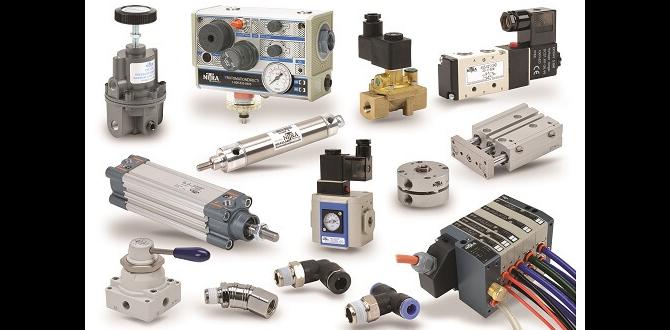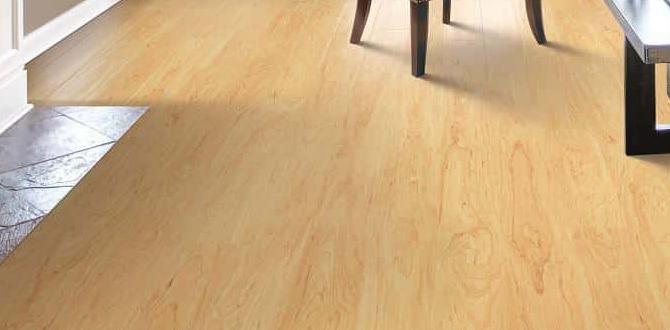The best nailer for crown molding is typically a pneumatic or cordless finish nailer in the 15-gauge or 16-gauge range. Look for adjustable depth settings, a slim nose, and a comfortable grip for precise installation.
You’ve got big plans for your home, and adding crown molding is a fantastic way to elevate its look. It adds a touch of elegance and sophistication that can truly transform a room. But when it comes to actually putting it up, the thought of choosing the right nailer can feel a bit overwhelming, especially if you’re new to DIY projects. You want that perfect, clean finish without a hassle. Don’t worry, I’m here to guide you through it. We’ll break down exactly what you need to know to pick the perfect nailer for your crown molding project, making sure you get professional results with confidence. Let’s get started on making your home shine!
Table of Contents
Why The Right Nailer Matters for Crown Molding
Installing crown molding isn’t just about picking any nail gun. There’s a sweet spot for nail size and gun type that makes the job much easier and yield cleaner results. Crown molding is often delicate and has intricate profiles. Using a nailer that’s too powerful or drives nails too large can split the wood, leave unsightly large holes, or even damage the molding itself.
A well-chosen nailer helps you:
Achieve a seamless fit: Precise nailing prevents the molding from pulling away from the wall or ceiling.
Minimize damage: Smaller gauge nails and adjustable depth settings ensure you don’t blow through the delicate material.
Work efficiently: The right tool speeds up the process, making installation faster and less tiring.
Get that professional look: Clean, countersunk nails that are easily filled create a polished finish.
Understanding Nailer Types for Crown Molding
When you’re looking at nailers, you’ll notice a few main types. For crown molding, we’re primarily interested in two categories: pneumatic (air-powered) and cordless (battery-powered).
Pneumatic Nailers
Pneumatic nailers are powered by compressed air from a compressor. They are often favored for their consistent power, lighter weight (as the motor is in the compressor, not the gun itself), and often lower price point for the gun.
Pros:
Usually lighter in hand than cordless models.
Consistent power output.
Generally more affordable upfront for the tool itself.
Longer lifespan, often considered more durable.
Cons:
Requires an air compressor, hoses, and an air source, which adds to the overall cost and setup.
The compressor can be noisy.
The air hose can be cumbersome to manage, especially around corners or in tight spaces.
Cordless Nailers
Cordless nailers run on rechargeable batteries. They offer incredible freedom of movement, as you don’t need to worry about air hoses or power cords. They use either a gas cartridge and battery system or an all-electric mechanism that drives the nail.
Pros:
Extreme portability and freedom of movement.
No air hoses or compressors needed, simplifying setup.
Quick and easy to use.
Cons:
Can be heavier due to the battery and motor.
Battery life can be a limiting factor for large projects.
Often more expensive upfront than pneumatic nailers.
Power can sometimes vary slightly based on battery charge.
For crown molding, portability and precision are key. While both types can work, many DIYers find the freedom of a cordless nailer very appealing for this type of trim work.
Gauge Matters: Why 15-Gauge and 16-Gauge are Your Best Bets
The “gauge” of a nailer refers to the diameter of the nail it drives. The lower the gauge number, the thicker the nail. For crown molding, you want a nail that’s strong enough to hold the molding securely against the wall and ceiling but slim enough to avoid splitting the wood or leaving a noticeable hole.
16-Gauge Nailers (Finish Nailers)
A 16-gauge nail provides a great balance for most crown molding applications. The nails are slim enough to be relatively inconspicuous and less likely to cause wood splitting, yet they offer decent holding power for trim that isn’t excessively heavy.
Nail Diameter: Approximately 0.062 inches (1.6mm).
Ideal For: Lighter to medium-weight solid wood crown molding, MDF crown molding, and polyurethane moldings.
Advantages: Minimal hole size, less splitting, good for finishing.
15-Gauge Nailers (Angled Finish Nailers)
A 15-gauge nailer drives a slightly thicker nail, offering a bit more holding power. This can be beneficial for heavier crown molding or if you want extra security. The hole left by a 15-gauge nail is slightly larger than a 16-gauge, but still qualifies as a “finish” nail and can be easily filled.
Nail Diameter: Approximately 0.070 inches (1.8mm).
Ideal For: Heavier wood crown molding, larger profiles, or situations where a very secure hold is paramount.
Advantages: Stronger holding power, good for heavier materials.
Why Not Other Gauges?
18-Gauge Nailers: These are too small for reliably holding crown molding. They are excellent for delicate trim or baseboards, but crown molding requires more support.
14-Gauge or Thicker: These nails are too thick for crown molding. They’ll leave large holes that are difficult to conceal and significantly increase the risk of splitting the molding, especially at the corners or where it meets the wall.
Key Takeaway: For most DIY crown molding projects, a 16-gauge finish nailer is your go-to. If you’re working with very substantial or heavy crown molding, a 15-gauge finish nailer is a solid option.
Essential Features to Look For in a Crown Molding Nailer
Beyond the type and gauge, several features can make your crown molding installation significantly smoother. Think of these as the “nice-to-haves” that can turn a tricky job into a satisfying one.
Adjustable Depth Setting
This feature is crucial. It allows you to control how deep the nail is driven into the wood without damaging the surface. You want the nail to be countersunk just enough so the head is below the surface, ready to be filled, but not so deep that it visibly dents the wood or pushes through the other side. A nailer with a simple thumbwheel or lever for adjustment is ideal.
Slim Nose with Swivel Belt Hook
The “nose” of the nailer is the part that contacts the wood before firing. A slim nose allows you to get into tight corners and angled areas where crown molding is often installed. Many nailers also come with a swivel belt hook, which, while not directly related to nailing, is super handy for hanging the tool on your tool belt when not in use, keeping it out of the way.
Firing Mode Selector (Sequential vs. Contact Actuation)
Nailers usually have two firing modes:
Sequential Firing: You must press the nose of the nailer against the wood (actuation) and then pull the trigger to fire one nail. This is the safest mode for precise placement.
Contact Actuation (Bump Fire): You hold the trigger down, and the nailer fires a nail every time you press the nose against the wood. This is faster but less precise and generally not recommended for delicate trim work like crown molding where accidental firings can cause damage.
For crown molding, sequential firing is almost always preferred. Look for a nailer that offers both modes, but ensure it clearly defaults to or easily switches to sequential.
Ergonomics and Weight
You’ll be holding this nailer for extended periods, often at awkward angles. A comfortable grip, balanced weight, and trigger ergonomics are vital. If you’re looking at cordless models, pay close attention to the battery placement and how it affects the overall balance of the tool. Holding a tool that feels “right” makes the job less strenuous and more enjoyable.
Nail Jam Clearing Mechanism
Nail jams happen. A nailer that makes clearing jams easy, preferably without needing tools, will save you immense frustration. Many modern nailers have tool-less jam-release mechanisms.
No-Mar Pad
Some nailers come with a soft, non-marring tip on the nose. This protects the surface of the wood from dents or scratches, which is a lifesaver when working with finished molding.
Comparing Top Nailer Options for Crown Molding
Let’s look at some specific nailer categories and what you might expect. While specific models change, these types represent common choices for DIYers.
Pneumatic 16-Gauge Finish Nailer
These are workhorses. Brands like DeWalt, Bostitch, and Hitachi (now HiKOKI) offer excellent pneumatic 16-gauge finish nailers. They are often lighter in the hand than their cordless counterparts and come at a lower tool price.
| Feature | Typical Specification | Benefits for Crown Molding | Considerations |
| :—————— | :——————————————————————————————— | :—————————————————————————————————————————– | :———————————————————————————————- |
| Gauge | 16-Gauge | Ideal balance of holding power and minimal wood damage. | 15-gauge is an option for heavier molding. |
| Power Source | Air Compressor | Consistent power, lighter tool weight. | Requires compressor, hose, and air hookups; can be noisy. |
| Magazine Capacity | 100-150 nails | Sufficient for most wall sections. | May need to reload during long runs. |
| Nail Length | 1 ¼” to 2 ½” | Crucial for securing various thicknesses of molding to studs or joists. | Choose length based on molding thickness and material. |
| Depth Adjustment| Dial or lever; often tool-less | Allows precise countersinking of nails without marring the surface. | Essential for a clean, fillable finish. |
| Firing Mode | Sequential and Contact (look for easy switch to sequential) | Sequential firing ensures accurate placement, minimizing errors. | Avoid bump fire for precise trim work. |
| Price (Tool Only) | $100 – $250 | Generally more affordable than cordless equivalent. | Compressor, hoses, and fittings are additional costs. |
| Weight | 3-5 lbs | Easier to handle for long periods or overhead work. | Still requires effort to maneuver hose. |
Cordless 16-Gauge Finish Nailer (Battery-Powered)
These are incredibly convenient for DIYers. Brands like Ryobi, DeWalt, Milwaukee, and Metabo HPT offer popular battery-powered 16-gauge finish nailers. They are perfect for jobs where running a hose is a hassle.
| Feature | Typical Specification | Benefits for Crown Molding | Considerations |
| :—————— | :——————————————————————————————————- | :——————————————————————————————————————————————- | :————————————————————————————————- |
| Gauge | 16-Gauge | Excellent for most crown molding, balancing strength and finesse. | 15-gauge cordless options are also available for heavier jobs. |
| Power Source | Rechargeable Battery (Lithium-Ion) | Ultimate freedom of movement, no hoses or compressor needed, quick setup. | Tool can be heavier; battery life is a factor; higher initial cost. |
| Magazine Capacity | 100-150 nails | Standard capacity, usually sufficient. | Ensure you have spare charged batteries for longer projects. |
| Nail Length | 1 ¼” to 2 ½” | Versatile for different molding depths and materials. | Match nail length to your molding and substrate. |
| Stall Force | Varies by model; look for one with good “stall force” to drive nails into harder woods. | Ensures nails can be driven flush even in denser materials. | Some models might struggle with hardwoods or very dense MDF. |
| Depth Adjustment| Dial or lever; often tool-less | Essential for precise nail depth and preventing surface damage. | Look for easy-to-use adjustment. |
| Firing Mode | Sequential and Contact (look for easy switch to sequential) | Sequential mode is key for accuracy and preventing mistakes on delicate trim. | Always use sequential mode for critical trim work. |
| Price (Tool Only) | $150 – $350+ (often sold as kit with battery and charger) | Higher upfront cost, sometimes including batteries, but no ongoing air costs. | Factor in the cost of extra batteries if needed. |
| Weight | 5-8 lbs (including battery) | Can be heavier than pneumatic, but no hose drag. Ergonomics are very important here. | Try holding it if possible to assess balance and comfort. |
Cordless 15-Gauge Angled Finish Nailer
While less common for DIYers than 16-gauge for general trim, these are excellent for specialized jobs. An angled nailer (often 15-gauge) can be very helpful for crown molding because its angled magazine allows you to shoot nails into tighter corners and angles that a straight nailer might not reach easily.
The main difference here is the 15-gauge nail and the angled magazine. The 15-gauge offers more holding power as discussed, and the angle is a practical advantage when fitting molding around complex corners or in shallow areas.
| Feature | Typical Specification | Benefits for Crown Molding | Considerations |
| :—————— | :————————————————————————————————————- | :——————————————————————————————————————————————————- | :———————————————————————————————————— |
| Gauge | 15-Gauge | Slightly thicker nail for better holding power; essential for heavier or trickier moldings. | Hole is marginally larger than 16-gauge, but still easily filled. |
| Magazine Angle | 20-22 degrees | Allows access to tight spaces and angles that are common in crown molding installation, reducing the need for pre-drilling or difficult maneuvers. | Can be slightly bulkier than a straight nailer. |
| Power Source | Battery-Powered (or Pneumatic) | Cordless offers portability; pneumatic offers consistent power. | Battery weight can be a factor; pneumatic requires compressor. |
| Nail Length | 1 ¼” to 2 ½” | Suitable for most crown molding thicknesses. | Match nail length to the specific molding profile and wall structure. |
| Depth Adjustment| Dial or lever; tool-less | Critical for setting nails below the surface without damaging the molding. | Look for a nailer with a reliable and easy-to-use depth adjustment. |
| Ergonomics | Varies by brand; look for good balance and comfortable grip, especially for cordless models. | Important for comfort during prolonged use at various angles. | If possible, test the feel of the tool before purchasing. |
| Price | $150 – $400+ (Cordless kits are usually pricier) | Good investment for the versatility and ease of use, especially for challenging angles. | Angled nailers can sometimes be more expensive than their straight counterparts. |
When You Might Need a Separate Air Compressor
If you opt for a pneumatic nailer, you’ll need a compatible air compressor. Here’s what to consider:
PSI (Pounds per Square Inch): Most finish nailers operate in the 70-120 PSI range. Your compressor needs to be able to supply this consistently.
SCFM (Standard Cubic Feet per Minute): This is the volume of air the compressor can deliver. For a single finish nailer, a compressor with an SCFM rating of around 2.0 to 4.0 CFM at 90 PSI is typically sufficient. You can find this information on the compressor’s specifications. A compressor with a higher SCFM rating will recover air faster, meaning less waiting between nail firings, especially if you’re using contact actuation (though not recommended for crown molding).
Tank Size: A larger tank (e.g., 6 gallons or more) will hold more compressed air, allowing you to shoot more nails before the compressor needs to cycle on to refill. For crown molding, where you might shoot nails more deliberately, a smaller tank is often adequate, but a larger one provides more buffer.
Portability: If you’ll be moving the compressor around your house or to different job sites, consider its weight and whether it has wheels.
Step-by-Step: Choosing Your Crown Molding Nailer
Let’s break down the decision-making process into simple steps.




